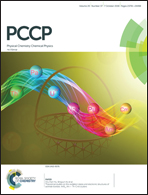Relativistic corrections to the ground states of HD and D2 calculated without using the Born–Oppenheimer approximation
Abstract
The Schrödinger equation for the ground states of the hydrogen molecules HD and D2 is solved variationally by treating the constituent particles of HD or D2 on the same footing without assuming the Born–Oppenheimer approximation. The variational basis sets are constructed using Hylleraas coordinates that are traditionally adopted for few-electron atomic systems. The nonrelativistic energy eigenvalues are converged to the level of 10−6 cm−1. The leading-order relativistic corrections, including relativistic recoil terms, are calculated rigorously. Together with the higher-order relativistic and quantum electrodynamic corrections obtained by the Pachucki's group [Phys. Rev. A., 2017, 95, 052506; Phys. Rev. Lett., 2018, 120, 153001], we determine the dissociation energy of D2 to be 36748.36240(28) cm−1, which agrees with the recent experimental result of Liu et al. [J. Chem. Phys., 2010, 132, 154301] 36748.36286(68) cm−1. For HD, the dissociation energy determined by us is 36405.78252(27) cm−1, which deviates from the most accurate experimental result of Sprecher et al. [J. Chem. Phys., 2010, 133, 111102] 36405.78366(36) cm−1 by about 2σ.

- This article is part of the themed collection: 2018 PCCP HOT Articles


 Please wait while we load your content...
Please wait while we load your content...